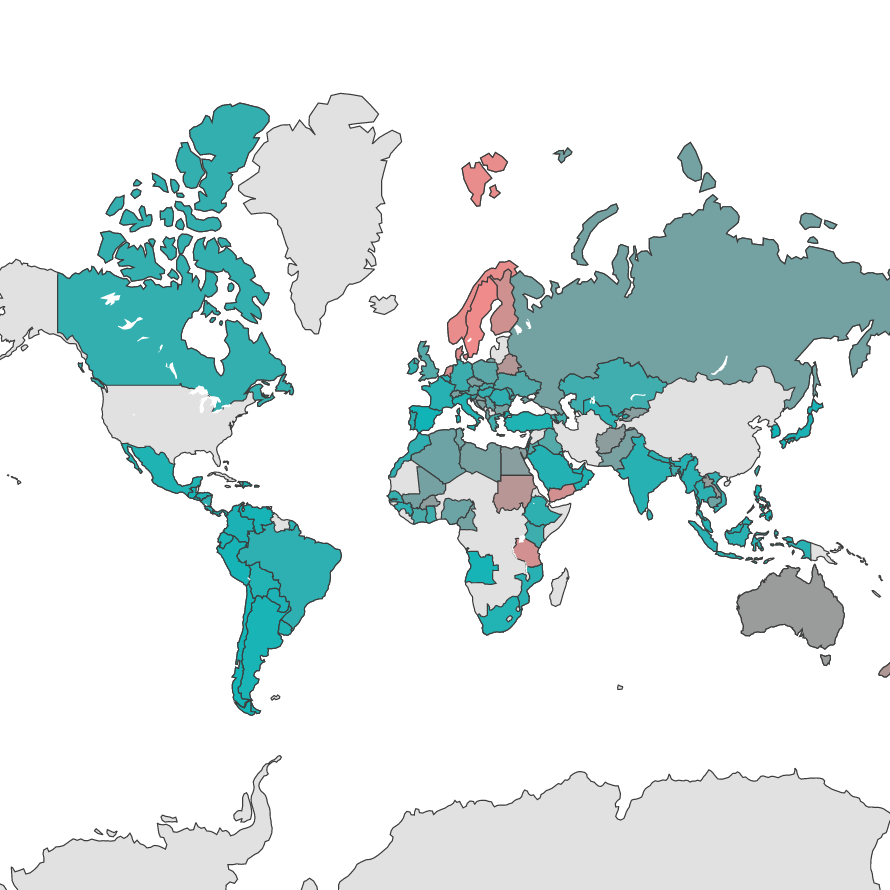
October 12, 2020
By Ting-Hsuan Chang1, Elena Badillo Goicoechea1, Elizabeth Stuart1, Esther Kim2, Katherine Morris2, Sarah LaRocca2, Curtiss Cobb2, Xiaoyi Deng3, Samantha Chiu3, Adrianne Bradford3,Frauke Kreuter3,4
[The Global COVID-19 Trends and Impact Survey is a partnership between The University of Maryland, Carnegie Mellon University, and Facebook Data for Good. Data represented in the map are from the international version of the survey and do not include data from the United States. The prevalence of mask usage is defined as the weighted proportion of respondents who indicated that they wore a mask all of the time or most of the time when in public.]
Over the past several months, the use of a face covering or mask has been highlighted as one of the most crucial and cost-effective mitigation measures to slow the transmission of COVID-19. In addition to the recommendations and mandates for mask usage from various government and public health officials, an increasing number of scientific studies have demonstrated the effectiveness of masks and universal masking in preventing COVID-19 transmission.(1, 2) Yet, compared to the growing list of efforts that support the widespread usage of masks, our understanding on the global adoption of mask-wearing behavior has been relatively inadequate due to the limitations of past studies which include small sample size and limited temporal and spatial coverage.
To better understand the global trends of mask usage, we used data from the International UMD Global CTIS, which is a large daily survey in partnership between The University of Maryland and Facebook Data for Good. Sampled Facebook users are invited to participate in the survey via an invitation at the top of their News Feed, and the surveys are conducted and collected off the Facebook app by The University of Maryland (previously published sampling and weighting methodology can be found here and here). In the analytical sample, we included responses from 19 million adults aged 18 years or older living in 114 countries and territories so far.
From April 2020 until present, the survey asked the participants, “In the last 7 days, how often did you wear a mask when in public?” In the interactive map that is featured above, we aggregated the proportion of respondents who indicated that they wore a mask all of the time or most of the time when in public.
The trends over the last five months demonstrate that in certain regions, including Asia and Central and South America, there was a consistently high prevalence (>75%) of mask usage (see figure above for weekly trends in Colombia, Japan, and Mexico), while in Northern Europe, there was a consistently low prevalence (<25%) of mask usage (see figure above for Denmark, Finland, and Sweden). In some countries we observed an increase over time (see figure above for Australia, Canada, and the United Kingdom), which may reflect the rising cases of COVID-19 or mask-related mandates and recommendations.
These and related data can help inform public health communications campaigns and initiatives regarding mask wearing to help slow the spread of COVID-19 and could be used to help examine how policies relate to practice around the world.
Updated on December 10, 2021:
Note on the limitations of the survey: The Global COVID-19 Trends and Impact Survey (CTIS), formerly known as the COVID-19 Symptom Survey, is subject to several limitations, many of which are common to web surveys. Anyone using the data to make policy decisions or answer research questions should be aware of these limitations, which are detailed here.
Given these limitations, we recommend using CTIS data to highlight trends across time or differences between groups, rather than focusing on total population estimates. We also strongly encourage users with access to the individual level data to consider whether additional corrections are needed to the weights, whether multiple imputation is needed to correct for missing data, and whether augmenting the survey with data collected from other sources, such as official data on testing, hospitalizations, and vaccinations or surveys that include respondents that do not have access to the internet, is needed for their research question(s)
To stay updated on survey questionnaire revisions and errors related to the survey instrument and data processing, sign up for our mailing list and check the Notices and Updates page regularly.
For more information on the UMD Global CTIS and how to access the data, please follow the link here for the international version of the survey and here for the US survey. For more information on mask usage in the US, click here.
References
- Wang X, Ferro EG, Zhou G, Hashimoto D, Bhatt DL. Association between universal masking in a health care system and SARS-CoV-2 positivity among health care workers. JAMA. 2020;324(7):703–704. doi:10.1001/jama.2020.12897
- Zhang R, Li Y, Zhang AL, Wang Y, Molina MJ. Identifying airborne transmission as the dominant route for the spread of COVID-19. PNAS. 2020;117(26):14857-14863. doi: 10.1073/pnas.2009637117
Author Affiliations
- Johns Hopkins Bloomberg School of Public Health, Maryland, USA.
- Facebook Research
- University of Maryland, Maryland, USA.
- Ludwig-Maximilians-Universität München, Munich, Germany


